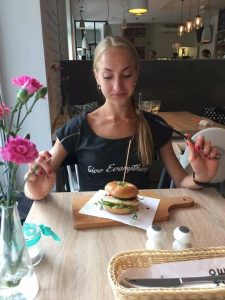I liked dancing since I was a child. I danced. I have not liked eating since I was a child. I did not eat it. During subsequent stages of education and trying to realize my dreams, I noticed a close relationship between the condition of the dancer and nutrition. And although I did not manage to finish the ballet school, at the right moment for myself, I understood that as an adult man one should go there and take care of students, and then dancers of the Ballet Group at the National Opera. My job is to learn the right choices, composing the menu, counseling during the reduction or weight gain, but also deriving from clinical incapacity, such as anemia, allergies, intolerances and eating disorders. And this is the best job I’ve ever come up with.
A very important element to obtain any fitness and skills in the profession of a ballet artist is health care. The most important role here is played by proper nutrition. It is not true that a classical dancer is eating carrots and lettuce. Athletes’ strength and swan grace, of course, have to go together, but for this you need, despite appearances, high quality of food and appropriate rules for its planning. Classical dance requires not only talent and technique, but also the preservation of proper body mass, which is needed to perform most dance movements, but also for aesthetic reasons. In this profession it is natural and obvious. The menu of every ballet artist – regardless of age – contains unprocessed, fresh, colorful and easily digestible products, directed more towards vegetable meals, but with the addition of well-absorbed proteins, eg eggs or lean meat. Nutrition plans should be adapted individually: to preferences, physiology, financial, technical and time possibilities.
The proper hydration is very important. In addition to highly mineralized water, herbal infusions and delicate tea with spices are also perfectly suited. Work at the ballet hall usually starts at 10:00. Before that, a good warm-up and “tuning” of the mind, and to make it possible, one should first eat the first breakfast. Then a light, nutritious lunch that will supplement energy, a small snack in the break and dinner – the lightest of all meals. Fat and fried foods are excluded here, cereal products – pasta, rice, cereal and bread, nuts and fruit. The evening menu features steamed fish, eggs, lean meats and a vegetable and herbal bouquet. What does an example of a well-composed ballerina menu look like?
Breakfast
2 hard-boiled eggs, 1/3 of avocado, celery sticks, tomato sprinkled with pumpkin seed oil, sunflower seeds, red tea
Lunch
Roasted turkey breast with herbs, buckwheat, lamb’s lettuce with cucumber, white radish and chia seeds, water with mint and lemon
Snack
A handful of macadamia nuts, an orange
Supper
Cod on roasted pumpkin and beetroot sprinkled with olive oil, fennel infusion
On the photo – Palina Rusetskaya


